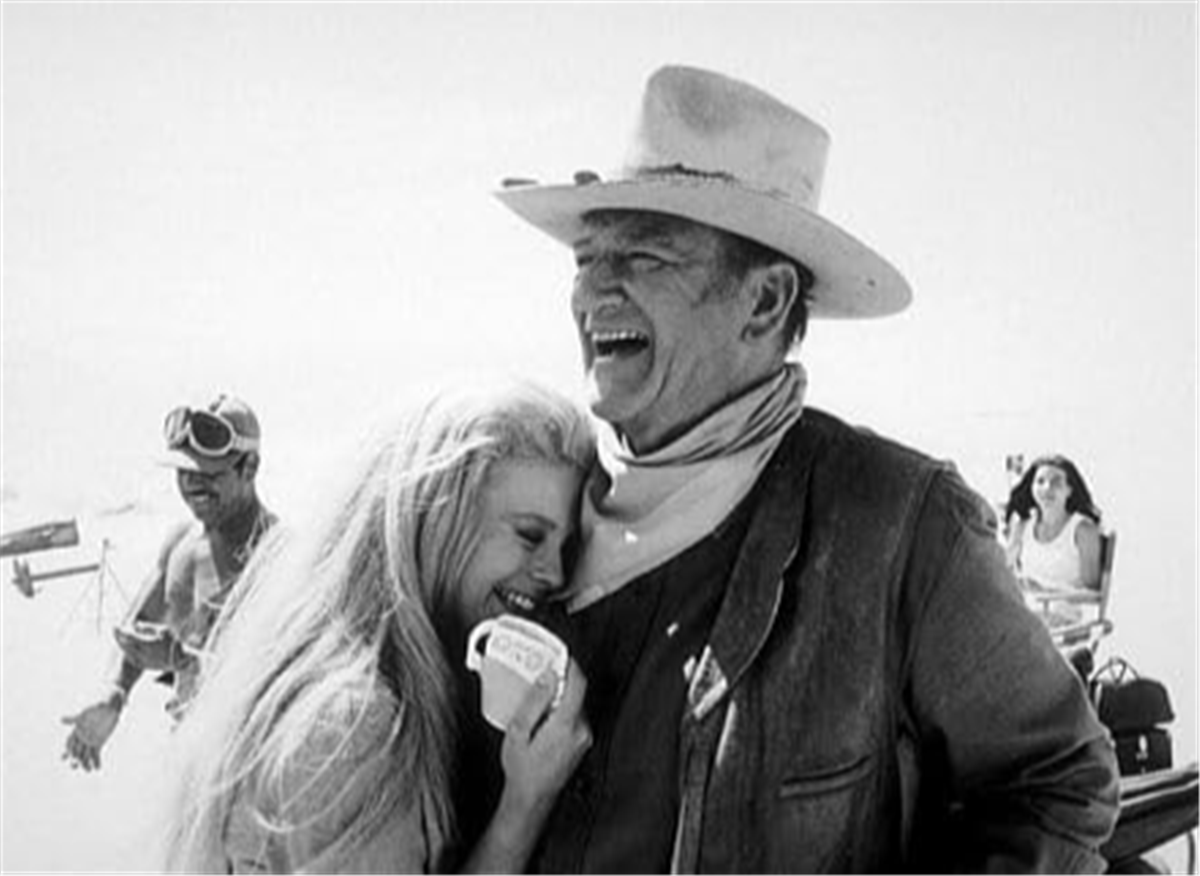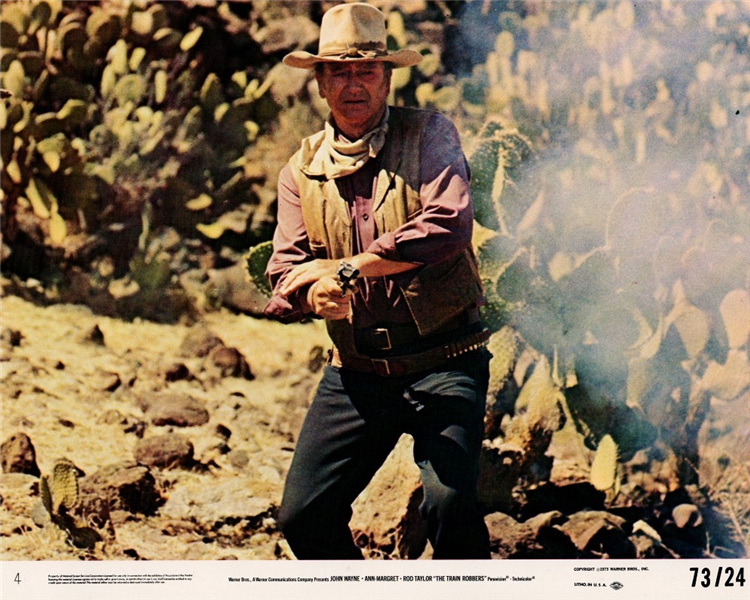In one of his last outings as the legendary Western hero, John Wayne joins up with a team of adventurers, played by Rod Taylor, Ben Johnson, etc. to help out Ann-Margaret’s widow recover half-a million dollars worth of gold from Mexico in this Burt Kennedy written and directed 1973 Western.
The Train Robbers(1973), written and directed by Burt Kennedy, is not a well known entry in John ‘Duke’ Wayne’s iconic film cannon. Maybe rightfully so; there’s nothing remarkable or outstanding about this Western. It’s an unpretentious and old-fashioned John Wayne star-vehicle, and not a great one at that. The film pales in comparison to late-career Duke Westerns like McLintock! or even Big Jake that Duke made just before this film. It’s a very simple and simplistic film, with Duke reprising his trademark character of the honorable, decent and courageous hero of the old-west, who sets forth on a mission with his pals, played by his regular co-stars like Ben Johnson and Christopher George. But Duke never made a Western that’s a total loss or totally unenjoyable, and the same goes for this film too. Also, one can always trust writer\Director Burt Kennedy to bring some freshness to the formula. Thankfully he does, even if it’s only on a smaller scale: this time, there’s a welcome addition in the form of the glamorous and mysterious Ann-Margaret, who not only manages to accompany the men on their adventures, but also forms the pivotal point of the film’s narrative; and then there’s a surprise twist at the end which we don’t see coming; it adds new dimensions to Ann-Margaret’s character as well as the title of the film. Kennedy, who started out his career by writing well-regarded, spare, minimalist Westerns for Bud Boetticher- Comanche Station, Seven men from Now, etc., uses a visual style for this picture that’s very similar to the one employed by Boetticher for those ‘Randolph Scott’ Westerns: minimal number of characters set against an almost baron, uncluttered land scape where even the skies are cloudless. There are very few buildings in this landscape, and whatever there is, is blown to smithereens by the end. Kennedy also adds a good deal of comedy to the proceedings, in the vein of satirical Westerns like “Support your local Sherriff” that he was making with James Garner at the time.
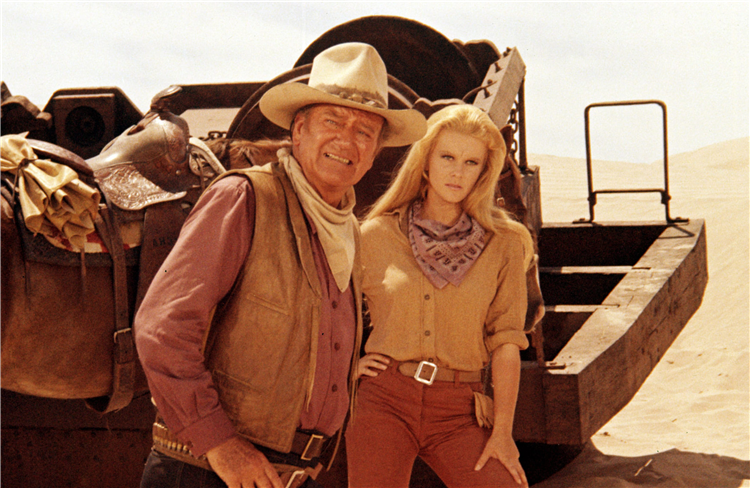
Now coming to the film, though Duke detested the spaghetti Westerns for ruining the myth, mystery and morality of the old-West that formed the cornerstone of all traditional American Westerns, and particularly the ‘John Wayne Westerns’, the fact remains that, by the 1970s, almost every Western made anywhere in the world were influenced by these Euro-Westerns pioneered by the likes of Sergio Leone and Sergio Corbucci. So, The Train Robbers, cannot be an exception. The film begins with a sequence that’s directly influenced from the opening scene in Leone’s “Once upon a time in the West”. We have a train station in the middle of nowhere, and a trio of gunslingers killing time, waiting for the train to arrive. But, unlike the Leone Westerns which are cynical in nature, Duke’s films are not; they are meant to be feel-good and optimistic, so, as opposed to the trio of gunslingers waiting to gun down the hero, Charles Bronson, on his arrival in Leone’s Western, here, it’s the hero’s friends who are waiting to receive him, just before they set forth on a rambunctious adventure. The hero is Lane (played by who else but the big Duke himself), yeah just Lane, not Hondo Lane, but the character is the same. After playing some powerful, wealthy patriarchs in Chisum and Big Jake, the film finds Duke returning to play the loner\wanderer\gunslinger]leader of a band of men characters that made him a megastar. The men waiting for him at the station in the small town of Liberty, Texas is Middle-aged Civil War veteran Will Jesse(Ben Johnson) and his friends Grady(Rod Taylor) and Ben Young(Bobby Vinton) and hired guns Calhoun(Christopher George) and Sam Turner(Jerry Gatlin). When Lane arrives on the train a day late, the men are taken aback to find him with a pretty, young woman whom he introduces as their new employer, Mrs. Lowe; yup! the same one played by Geraldine Page in “Hondo”, Only this time the character is played by the young, voluptuous, Ann-Margaret, but her backstory is the same: virtuous widow (also hard-drinking, as we later find out) abandoned by her caddish husband, who got killed, leaving her to raise a young boy all by herself. Her presence disappoints Jesse & Co. who were expecting a return to exciting adventures with Lane, with whom they served in the Civil War on the Union side and were part of the terrible battle of Vicksburg. Lane’s refusal to explain her presence among them also annoys the would-be adventurers, who starts turning on Lane much to the annoyance of the latter. He was looking for men who would stand alongside him not against him, and his wrath falls on Grady in the form of his fist.
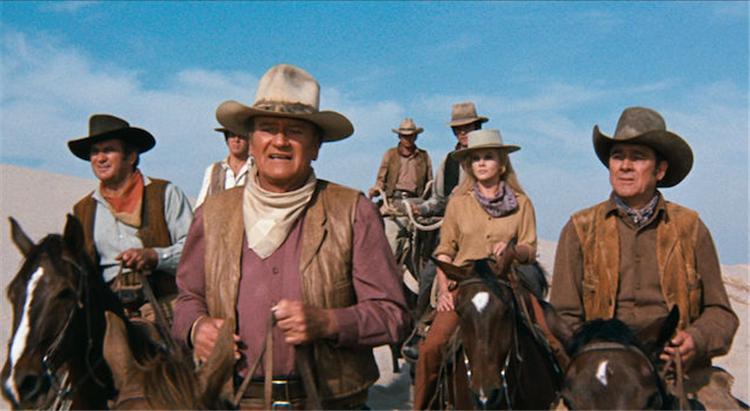
Later in the Saloon, Lane mellows down and explains the whole setup: they are to help Mrs. Lowe recover the half-million dollars worth of gold that her husband, a burglar, long ago stole from a train, and then hid in some Mexican desert. Only she knows where. But the prize isn’t the gold; Mrs. Lowe intends to return the money to the Wells Fargo bank to clear her husband’s name so that their little son can grow up with his honor intact. This bit of news is disheartening for Wayne’s comrades, but Lane adds that there is a $50,000 reward for the return of the gold, and that’s what they will be risking their necks for. And risking their necks they are; because Mr. Matt Lowe’s gang is still looking for the gold; while two of the gang died before Lowe, seven men remain and have been searching for Mrs. Lowe and the gold for five years, so Lane and the men must provide her protection. The next morning, after calming an unruly pack mule loaded down with dynamite, the men all gape at Mrs. Lowe, who appears in riding pants and a tight shirt with her long hair flowing. Lane explains that it is best Mrs. Lowe’s presence be obvious, so they will not come under attack until they reach the gold. After initial misgivings about endangering a woman on a long ride through the desert, Lane and company head out. Before they leave the station, Lane has Mrs. Lowe’s shirt boiled so that she will stand out and her late husband’s gang won’t mistake her as a man and try to shoot her. A few hours after the group departs, a train arrives in Liberty carrying twenty riders in pursuit of Mrs. Lowe (again, something straight out of a revisionist Western, this time from “Butch Cassidy and the Sundance Kid”). That night after setting up camp, Lane and the men prove solicitous to Mrs. Lowe, who is amused and surprised at their diffidence. The following morning, Lane berates Calhoun for falling asleep on guard duty, allowing the pack mule carrying the dynamite to be stolen. After riding most of the day, the group arrives in a small town where they hear a mule offering resistance to several men. Translating the Spanish discussion, Lane informs the group that the thieves hoped to use the dynamite on the mule to free jailed compatriots, but they have been unable to handle the rambunctious animal. After reclaiming the mule, Lane and the others proceed until nightfall, still uncertain how large the party is following them. That evening sitting apart from the others with Lane, Mrs. Lowe admits to having doubts about her decision and wonders if she should simply keep the gold. When Lane points out that she would indeed be rich, but her son would have thieves for parents, Mrs. Lowe laughingly agrees. The next day, upon crossing a river, Mrs. Lowe falls off her horse and, not realizing that she cannot swim, the men are slow in coming to her assistance. Later, attempting to comfort the cold, wet woman, Lane offers her whisky and the two get drunk.
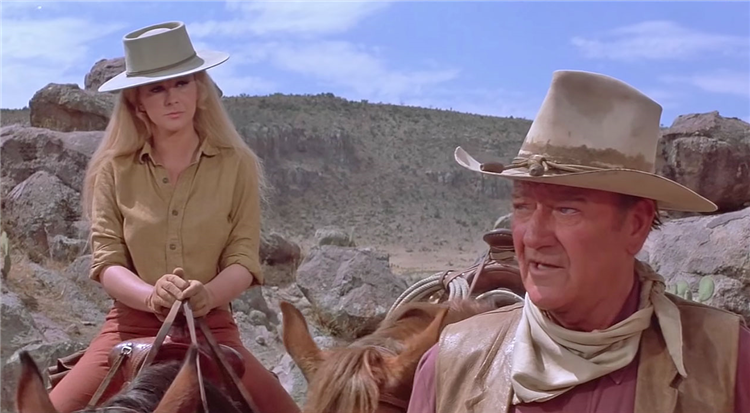
The next morning, after Mrs. Lowe angrily accuses Lane of purposely getting her inebriated in order to find out the exact location of the gold, Lane, disgusted by his own behavior, announces his intention to turn back. Just then, the group spots a line of men on horseback watching them from the opposite ridge and Lane guides them hastily into a mountain pass. Perplexed, Jesse asks Lane why he is running from a fight and giving up when they have come so far. Angered, Lane takes Mrs. Lowe aside and demands to know the exact location of the gold, which she admits is in the boiler of a train engine abandoned in the Mexican desert. Following a sandstorm, the group again spots their pursuers on a nearby hill, but when Lane pointedly displays Mrs. Lowe to them, shots ring out and the group panics and flees. The men on the hill also receive fire and take cover. Unknown to both camps, Another man, a well-dressed, ominous looking guy forever smoking a cigar, has been following them. He fired on each of the parties to prevent a conflict. Reaching the half-buried train engine, Lane’s men work on unearthing the cargo box. Knowing that since the gold has been located, their pursuers will not hesitate to attack, Lane decides to use the old engine as cover and wait. Late that afternoon, the assault begins, but the engine offers solid protection and Lane and the others kill ten of their attackers. That evening, Lane arranges to sneak into the enemy camp and set off a diversion with dynamite in order to chase the horses away. Despite Ben receiving a leg wound and fumbling the dynamite, the plan is successful and before dawn, Lane and the others slip away. Uncertain whether the survivors will rally to resume the chase, Lane drives the group hard and by nightfall of the second day they reach Liberty. Suspecting that their pursuers may have arrived ahead of them, Lane leaves Ben to guard Mrs. Lowe while he and the others surround the saloon. Attacked the moment they enter the saloon, the men scatter and during the ensuing gunfight, the attackers set fire to the hotel, under whose porch Ben and Mrs. Lowe are hiding. While Grady, Calhoun and Sam provide covering gunfire, Lane and Jesse hurl the last of the dynamite at their enemies as Ben pulls Mrs. Lowe to safety.
I do feel a little embarrassed to put spoiler tag on a 50 year old film and that too a John Wayne Western, but i don’t want to spoil the final twist for those who have not seen it, as it is one of the really good things about the film. The next morning, Lane and the others escort Mrs. Lowe and her suitcase of gold to the train where Jesse announces that the men have decided to let her keep the reward money for her son. Touched, Mrs. Lowe thanks the men for their kindness and protection, then boards the train. As the men walk away, the ‘mysterious man with the cigar’ (played by Ricardo Montalbán ) greets them from the back deck of the caboose and informs them that he is a Pinkerton agent working for Wells Fargo, and has been tracking the stolen gold for five years. As the train is pulling out, the Pinkerton man relates that he witnessed Lowe’s murder at a brothel as did the woman they know as Mrs. Lowe, whose real name is Lilly (with a double ‘L’ as he specifically points out). Before entering the train car, the Pinkerton man calls out that Lowe was never married and had no children. Taken aback by this revelation, the men gape at the departing train until Lane gallops by, announcing that he is off to rob a train. Thus, the title “The Train Robbers” attains a new meaning, and so does the ‘virtuous widow’, Mrs. Lowe, turned ‘whore who stole the gold’ Ms. Lilly. That’s a typical Burt Kennedy twist, folding the Madonna and whore into one; also, allowing a woman to beat the big Duke hands down. By this time, Duke had learned to make fun of himself (or his image) as well. In an earlier scene, when Ann-Margaret , who’s young enough to be his daughter, tries to come on to him, he chastises her by saying: “I’ve got a saddle that’s older than you are, Mrs. Lowe.” In this film, Duke doesn’t hide the fact that he’s old and, by god, he does look really old in this film, especially when he takes off his hat . The final twist also puts Mrs. Lowe’s behavior (throughout the film) into context. She looks confident and comfortable in the company of males, very unlike a timid widow, and it’s she who intimidates them. She is also quick to suspect them of treachery, particularly post the drinking episode with Lane, which proves that she has been around this kind of men a lot; it also explains why she keeps coming on to a much older Lane; at one point, she takes off her shirt and throws at Lane’s face and stands on the balcony with an inviting look. I only wish that the film hadn’t ended so abruptly, and there was much more made of this twist. Another meeting between Duke and Ann-Margaret, where the latter could get to show her true colors would have been really great.
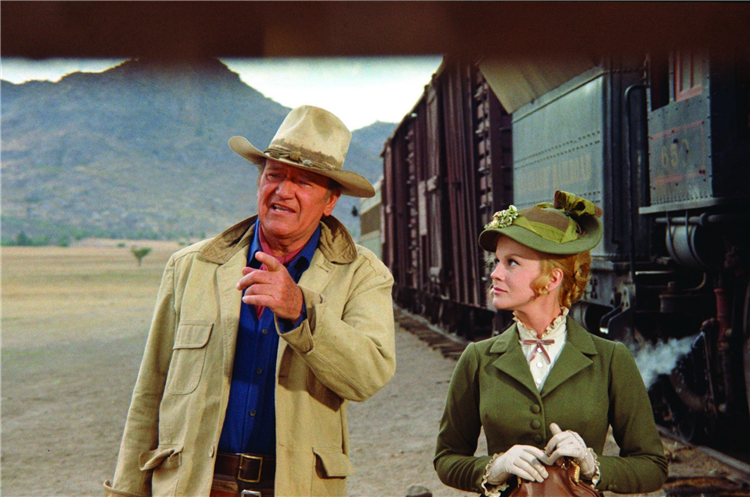
This was Burt Kennedy’s second film with Duke, and it would also be their last together. Kennedy had written the script for this film with Duke in mind, but he later regretted making it with Duke, because he felt that he was forced by Duke to use actors that were not suitable for the roles, and it hurt the film. I’m not sure which actors he meant, because i felt everyone did well with what they got, and if there were any issues, it was with the script. Before this film, they had made the superior, The War Wagon(1967), together, which had a stellar star cast comprising Kirk Douglas. That was a very well conceived and executed film with a strong plot and a colorful bunch of characters. It may have also helped that Duke himself was 6 years younger then. The turns of this story and characterization are mostly predictable and not very important. The emphasis, as always, is on character interactions and conversation among the friends around the campfire: it’s full of good memory and decent conviction, and this is where “The Train Robbers” comes alive And, of course, there’s the great cast who seems to live and breathe in this milieu, led by the gentle giant, John Wayne, to carry them through. Duke gives the ever-likeable, characteristic ‘John Wayne’ performance. He had broken a couple of ribs while making this film, which made it impossible for him to move around, and hence is always photographed either sitting on on the horse or standing on the ground. He’s supported wonderfully by Ben Johnson and Rod Taylor giving restrained performances. Rod Taylor was a friend of Wayne’s, but this was their first chance to work together. Christopher George, now a regular in Wayne’s films, gave his usual quality performance. Ann-Margret, as always, is a feast for the eyes. She too was coming off some accident that made it problematic for her to ride horses, but she managed it well in the end. Her performance has a quiet, mischievous, mysterious undertone throughout, and it allows the final twist to be plausible.
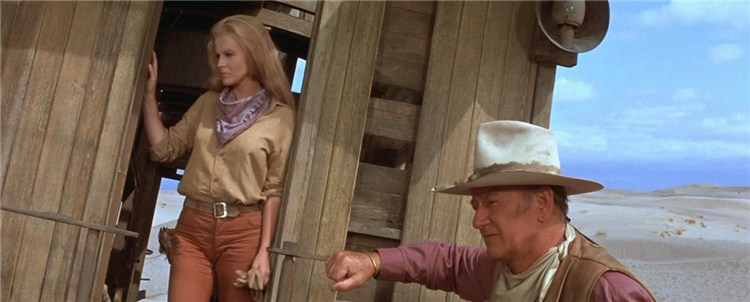
The Train Robbers was shot on location in Durango, Mexico. The entire town of Liberty was built north of Durango for the production. The town, which cost $100,000 to construct, was subsequently destroyed in the film’s climax. The film is beautifully photographed by Duke’s regular DP, William H. Clothier. The composition of each and every widescreen frame and the arrangement of actors in them is impeccable. The selection of the locations also appear very new, not the ones we have already seen in Chisum or Big Jake, which were also shot in the same part of the world. This was Clothier’s final film. He was seventy years old and had been thinking about quitting for some time. He enjoyed working with Duke, but it was always strenuous because Duke insisted on working from 6 A.M. right until the sun goes down, and Clothier was finding it difficult to adjust to this in his advancing years. Duke and Clothier had been working together since Fort Apache, but in recent times, making films with Duke wasn’t much fun anymore. There was a general lack of quality, compared with the great Ford movies or even their 60s movies. they made together. “The Train Robbers” had an excellent cast and is beautifully photographed, but the fact was that they just didn’t have a good enough script, and they were trying to make up for the story in production values and cast. The behavioral and emotional values of vintage John Wayne films were missing here, the pleasures were getting limited to the physical, both of the scale of the production as well as the performances. All these factors contributed to Clothier retiring. He too realized that Duke was nearing the end of his career. The Train Robbers cost a little more than $4 million and earned less than half of what was required to break even. The failure of the film hurt Burt Kennedy the most, and for Duke, the writing on the wall was clear: his kind of movies were on the way out; the movies that were making big money were The Godfather, The Exorcist, Dirty Harry and its sequels and so on. Films that were far removed, and almost existing in a different universe to that of the John Wayne Westerns. But today, watching this film is a pleasurable experience. it’s very much a John Wayne Western programmer than a John Wayne classic; It’s very lightweight entertainment, but as Quentin Tarantino said about this film: “It’s so light it’s barely a movie, but that doesn’t mean it’s not amusing.” I do concur with Tarantino. Duke would make just 5 more movies after this before he retired triumphantly with the superb, Don Siegel directed, The Shootist, in 1976.
